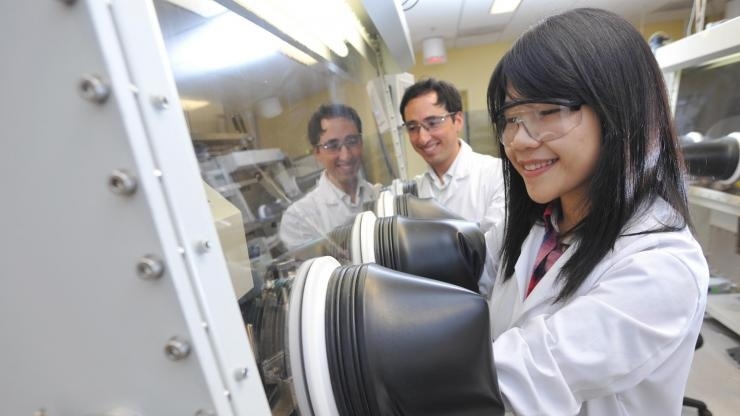Dec 6 2016
 Graduate students Felipe Larrain and Wen-Fang Chou testing the performance of the single layer solar cells developed at Georgia Tech using a new electrical doping technique. (Credit: Christopher Moore, Georgia Tech)
Graduate students Felipe Larrain and Wen-Fang Chou testing the performance of the single layer solar cells developed at Georgia Tech using a new electrical doping technique. (Credit: Christopher Moore, Georgia Tech)
A simple solution-based electrical doping method could help decrease the cost of organic electronic devices and polymer solar cells, potentially broadening the usage for these technologies. By facilitating manufacture of efficient single-layer solar cells, the new method could help transform organic photovoltaics into a new generation of wearable devices and permit small-scale distributed power generation.
This method was developed by a team of researchers from the Georgia Institute of Technology and colleagues from three other institutions. It offers a new approach of inducing p-type electrical doping in organic semiconductor films. The process requires immersing the films in a solution for a short span of time at room temperature, and would substitute a more complex method that requires vacuum processing.
Our hope is that this will be a game-changer for organic photovoltaics by further simplifying the process for fabricating polymer-based solar cells. We believe this technique is likely to impact many other device platforms in areas such as organic printed electronics, sensors, photodetectors and light-emitting diodes.
Bernard Kippelen, director of Georgia Tech’s Center for Organic Photonics and Electronics and a professor in the School of Electrical and Computer Engineering
Sponsored by the Office of Naval Research, the work was reported December 5 in the journal Nature Materials. The research also involved scientists from the University of California at Santa Barbara, Kyushu University in Japan, and the Eindhoven University of Technology in The Netherlands.
The method comprises of immersing thin films of organic semiconductors and their blends in polyoxometalate (PMA and PTA) solutions in nitromethane for a short span of time – on the order of minutes. During immersion, diffusion of the dopant molecules into the films occurs which causes efficient p-type electrical doping over a limited depth of 10 to 20 nm from the surface of the film. The p-doped regions display heightened electrical conductivity and high work function, decreased solubility in the processing solvent, and enhanced photo-oxidation stability in air.
This new technique provides a simpler substitute to air-sensitive molybdenum oxide layers used in a majority of efficient polymer solar cells that are usually processed using costly vacuum equipment. When the new doping technique was applied to polymer solar cells, it provided efficient hole collection. For the first time, single-layer polymer solar cells were showed by integrating this new technique with spontaneous vertical phase separation of amine-containing polymers that results in efficient electron collection at the opposing electrode. The geometry of these new devices is exclusive as the functions of hole and electron collection are integrated into the light-absorbing active layer, leading to the simplest single-layer geometry with few interfaces.
The realization of single-layer photovoltaics with our approach enables both electrodes in the device to be made out of low-cost conductive materials. This offers a dramatic simplification of a device geometry, and it improves the photo-oxidation stability of the donor polymer. Although lifetime and cost analysis studies are needed to assess the full impact of these innovations, they are certainly very exciting developments on the road to transform organic photovoltaics into a commercial technology.
Canek Fuentes-Hernandez, senior research scientist in Kippelen’s research group
By making the production of organic solar cells easier, the new processing method could allow fabrication of solar cells in areas of Latin America and Africa that are short of capital-intensive manufacturing capabilities, said Felipe Larrain, a Ph.D. student in Kippelen’s lab.
“Our goal is to further simplify the fabrication of organic solar cells to the point at which every material required to fabricate them may be included in a single kit that is offered to the public,” Larrain said. “The solar cell product may be different if you are able to provide people with a solution that would allow them to make their own solar cells. It could one day enable people to power themselves and be independent of the grid.”
Organic solar cells have been explored in several academic and industrial labs for years, and have experienced a continuous and consistent improvement in their power conversion efficiency with lab values reaching 13 % – compared to about 20 % for silicon-based cells available in the market. Though polymer-based cells at present are less efficient, they require less energy to manufacture compared to silicon cells and can be more easily recycled at the end of their service life.
Being able to process solar cells entirely at room temperature using this simple solution-based technique could pave the way for a scalable and vacuum-free method of device fabrication, while significantly reducing the time and cost associated with it.
Vladimir Kolesov, a Ph.D. researcher and the paper’s lead author
Other than solar cells, the doping method could be more widely used in other areas of organic electronics, explained Ph.D. researcher Wen-Fang Chou. “With its simplicity, this is truly a promising technology offering adjustable conductivity of semiconductors that could be applied to various organic electronics, and could have huge impact on the industry for mass production.”
Also at Georgia Tech, the research included professors Samuel Graham and Seth Marder, both from the Center for Organic Photonics and Electronics. Beyond Georgia Tech, the project also involved Naoya Aizawa from Kyushu University; Ming Wang, Guillermo Bazan and Thuc-Quyen Nguyen from the University of California Santa Barbara, and Alberto Perrotta from Eindhoven University of Technology,
This research was funded in part by the Department of the Navy, Office of Naval Research Award No. N00014-14-1-0580 and N00014-16-1-2520, through the MURI Center CAOP, Office of Naval Research Award N00014-04-1-0313 and by the Department of Energy through the Bay Area Photovoltaic Consortium under Award Number DE-EE0004946.